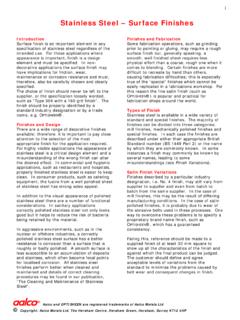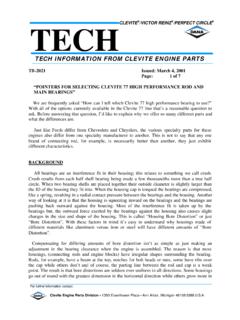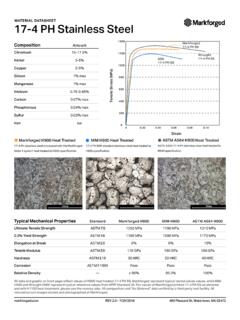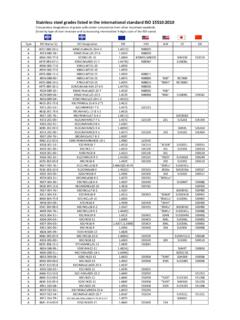Transcription of Stainless Steel – Specifications, Grades and Properties
1 Abc Aalc o is a registered trademark of Aalco Metals Ltd Copyright: Aalco Metals Ltd, The Hersham Centre, Hersham Green, Hersham, Surrey KT12 4HP Stainless Steel Specifications, Grades and Properties The name Stainless Steel covers a variety of corrosion resistant steels that contain a minimum of 11% Chromium. Changing the Chromium content and adding other elements like Nickel, Molybdenum, Titanium and Niobium changes the mechanical and physical Properties of the Steel . This results in hundreds of different Grades of Stainless Steel that are covered by a range of national and international standards. Grade Families Each one of the Grades is grouped into one of five Stainless Steel families. These families are named after their metallurgical microstructure. The five groups are austenitic, ferritic, duplex, martensitic and precipitation hardening .
2 Ferritic Stainless Steels The lack of other alloying elements means ferritic Stainless steels are known as plain Chromium steels. They have a Chromium content between 12 and 18%. The carbon content in ferritic Stainless steels is very low. Ferritic Stainless steels: Have moderate corrosion resistance Are not susceptible to stress corrosion Are magnetic Cannot be hardened by heat treatment Are always used in the annealed condition Poor weldability for most Grades Common ferritic Grades include the proprietary grade 430 Stainless Steel and the cheapest Stainless Steel , grade 409 Stainless Steel . 409 Stainless Steel is the material of choice for automotive exhausts due to its combination of low price, corrosion resistance and excellent formability. Austenitic Stainless Steels Adding nickel to Stainless Steel in sufficient amounts, changes the microstructure to austenite.
3 70% of commercially produced Stainless steels are austenitic. The most common grade of austenitic Stainless Steel is 304 ( ). Globally, 304 accounts for more than 50% of Stainless Steel consumed. A common name for 304 Stainless is 18/8. This name refers to the average composition, 18% chromium and 8% nickel. It is sometimes used generically for austenitic Stainless steels other than 304, even if the actual composition is vastly different. Some of the features of austenitic Stainless steels include: Excellent corrosion resistance Non-magnetic when annealed Rapidly work harden with cold work Not hardenable by heat treatment Ductile and readily formable Excellent weldability Hygienic with excellent cleanability Good performance at high temperatures Excellent performance at low temperatures Other than 304 Stainless Steel , other common austenitic Grades include the popular marine grade, 316 Stainless Steel and the machining bar grade, 303 Stainless Steel .
4 Martensitic Stainless Steels The first Stainless steels to be developed for commercial applications were martensitic Stainless steels. These steels were used for cutlery. When compared with other Stainless steels, the martensitic Stainless group have a relatively high carbon content ( - ). Like ferritic Stainless steels, they are plain chromium steels containing between 12 and 18% chromium. Features of martensitic Stainless steels include: X abc Aalc Inability to be cold formed o is a registered trademark of Aalco Metals Ltd Copyright: Aalco Metals Ltd, The Hersham Centre, Hersham Green, Hersham, Surrey KT12 4HP Martensitic Stainless Steels Moderate corrosion resistance Heat treatable Magnetic Poor weldability Martensitic Grades include 420 Stainless Steel , which is used in engineering applications like shafts and 440C Stainless Steel the hardest and most abrasion resistant of all the Stainless steels.
5 Duplex Stainless Steels Duplex Stainless steels get their name from the fact that they contain both a ferritic and austenitic microstructure. They have a relatively high chromium content of between 18 and 28%. Nickel content is moderate at to 8%. At this level, the nickel content is too low to generate a fully austenitic structure. This results in a duplex microstructure containing both ferritic and austenitic phases. Duplex Stainless steels also tend to contain molybdenum. The prime advantage of duplex Stainless is the combination of Properties derived from both austenitic and ferritic Stainless steels. Duplex Stainless steels have: Excellent corrosion resistance Increased resistance to chloride attack Good resistance to stress corrosion cracking Tensile and yield strength higher than austenitic or ferritic Grades Good weldability Good formability With excellent corrosion resistance the common duplex grade, 2205 Stainless Steel , is used in heat exchangers, chemical tanks and refineries.
6 precipitation hardening Grades precipitation hardening Stainless steels can be martensitic, semi-austenitic or austenitic. They offer the combined Properties of corrosion resistance from austenitic Grades with the heat treatability of martensitic Grades . precipitation hardening Grades , like 17- 4 ph (also known as 630 Stainless Steel ), are supplied as solution treated bars. They can then be machined before hardening . The hardening process is a single, low temperature, ageing step. Properties of precipitation hardening Grades include: Good to moderate corrosion resistance Good weldability Very high strength Magnetic Specifications Grade compositions, mechanical Properties and production specifications are governed by a range of international and national standards for Stainless Steel . While the old AISI three digit Stainless Steel numbering system ( 304 and 316) is still commonly used for the classification of Stainless Steel Grades , new classification systems have been developed.
7 These systems include a 1-letter + 5-digit UNS number, like S30400, as defined by SAE and ASTM. European countries are adopting unified Euronorm standards. These countries are either replacing or adapting their own country specific standards to mirror the Euronorm standards. Other designations being replaced include old BS and EN numbers like 304S31 and 58E. Some Grades are not covered by standard numbers and could be proprietary Grades or be named using standards for specialist products like welding wire. Stainless Steel standards are explained in detail in the British Stainless Steel Association Guide to Stainless Steel Specifications , also known as the BSSA Blue Guide . The following table lists a range of Stainless Steel Grades , their old BS designation, new UNS number and new EN designation. X abc Aalc o is a registered trademark of Aalco Metals Ltd Copyright: Aalco Metals Ltd, The Hersham Centre, Hersham Green, Hersham, Surrey KT12 4HP Specifications Grade UNS No BS Euronorm No.
8 301 S30100 301S21 302 S30200 302S25 303 S30300 303S31 304 S30400 304S31 304L S30403 304S11 304H S30409 - (302HQ) S30430 394S17 305 S30500 305S19 309S S30908 309S24 310 S31000 310S24 310S S31008 310S16 314 S31400 314S25 316 S31600 316S31 316L S31603 316S11 316H S31609 316S51 - 316Ti S31635 320S31 321 S32100 321S31 347 S34700 347S31 403 S40300 403S17 405 S40500 405S17 409 S40900 409S19 410 S41000 410S21 416 S41600 416S21 420 S42000 420S37 430 S43000 430S17 440C S44004 - 444 S44400 - 630 S17400 - (904L) N08904 904S13 (253MA) S30815 - (2205) S31803 318S13 (3CR12) S41003 - (4565S) S34565 - (Zeron100) S32760 - (UR52N+) S32520 - ASTM does not recognise the designations in brackets.
9 Many other Grades and specifications are available. Material supplied by Aalco has been manufactured to comply with a number of standards depending upon the product. Standards also cover the finish of the material. Mechanical Properties Required mechanical Properties are normally given in purchase specifications for Stainless steels. Minimum mechanical Properties are also given by the various standards relevant to the material and product form. Meeting these standard mechanical Properties indicates that the material has been properly manufactured to an appropriate quality system. Engineers can then confidently utilise the material in structures that meet safe working loads and pressures. Mechanical Properties specified for flat rolled products are normally tensile strength, yield stress (or proof stress), elongation and Brinell or Rockwell hardness.
10 Property requirements for bar, tube, pipe and fittings typically state tensile strength and yield stress. Yield Strength Unlike mild steels, the yield strength of annealed austenitic Stainless steels is a very low proportion of the tensile strength. Mild Steel yield strength is typically 65-70% of the tensile strength. This figure tends to only be 40-45% in the austenitic Stainless family. Cold working rapidly and greatly increases the yield strength. Some forms of Stainless Steel , like spring tempered wire, can be cold worked to lift the yield strength to 80-95% of the tensile strength. X abc Aalc o is a registered trademark of Aalco Metals Ltd Copyright: Aalco Metals Ltd, The Hersham Centre, Hersham Green, Hersham, Surrey KT12 4HP Tensile Strength Tensile strength is generally the only mechanical property required to define bar and wire products. Identical material Grades may be used at various tensile strengths for completely different applications.






